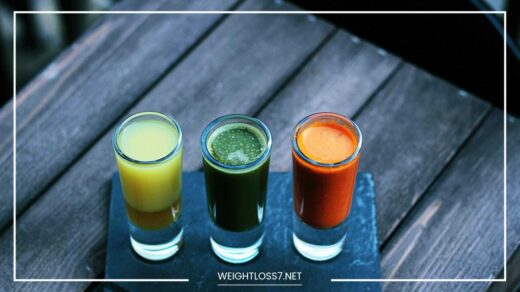The Truth About Negative Calorie Foods

Negative Calorie Foods
The Allure and Illusion of Negative Calorie Foods: Embracing Filling Foods for Sustainable Weight Loss
In the ever-evolving quest for weight loss, enticing shortcuts and quick fixes constantly emerge. One such captivating notion is the concept of “negative calorie foods.”
These mythical dietary heroes are said to possess the magical ability to require more calories to burn than they actually contain, essentially leading to effortless weight loss.
But before you envision yourself living off a diet of celery sticks and watermelon slices, let’s embark on a scientific exploration to debunk the myth and discover effective strategies for sustainable weight management.
Unveiling the Science (or Lack Thereof) Behind Negative Calories
The alluring theory of negative calorie foods hinges on the Thermic Effect of Food (TEF). This term represents the energy your body expends to digest, absorb, and store the nutrients from your meals.
It’s true that TEF exists, and it can contribute up to 10% of your daily calorie expenditure. However, there’s a crucial caveat: no scientific evidence supports the existence of any food that requires more energy to process than it provides.
While some fruits and vegetables, like celery, boast a low-calorie count and high water content, the human digestive system is a marvel of efficiency.
Chewing, breaking down food with stomach acid, and absorbing nutrients are all streamlined processes that don’t magically burn more calories than they take in.
Here’s a deeper dive into why negative calorie foods are unlikely to exist:
- The Laws of Chemistry: Even the most low-calorie foods contain calories derived from carbohydrates, protein, and fat. Your body can break down these nutrients and extract energy, even if it’s a minimal amount.
- Evolutionary Efficiency: The human digestive system has evolved over millennia to be adept at extracting energy from food sources. From chewing to absorbing nutrients, these processes are designed for efficiency.
- Individual Variations: While TEF can vary slightly from person to person depending on factors like age, weight, and body composition, these variations aren’t significant enough to create a negative calorie scenario.
Filling Foods: The Powerhouse for Sustainable Weight Loss
While negative calorie foods might be a myth, the underlying concept holds a valuable truth: focusing on low-calorie, high-fiber foods can be a powerful strategy for weight management. Here’s why:
- Satiety Boost: Low-calorie, high-fiber foods are more filling, keeping you feeling fuller for longer and reducing cravings. This natural decrease in hunger pangs can lead to a lower overall calorie intake throughout the day.
- Nutrient Powerhouse: Fruits and vegetables are brimming with essential vitamins, minerals, and antioxidants that contribute to overall health and well-being. These micronutrients not only support bodily functions but can also enhance energy levels and metabolism.
- Hydration Hero: Many low-calorie foods boast a high water content, which plays a crucial role in hydration. Staying adequately hydrated can not only curb hunger but also improve satiety and digestion.
Let’s delve into some fantastic “filling foods” that can be incorporated into your weight loss plan for a more sustainable approach:
- Fruits: Berries (blueberries, raspberries, strawberries), apples, pears, grapefruits, melons (watermelon, cantaloupe) are all excellent choices. They offer a burst of sweetness, essential vitamins, and fiber.
- Vegetables: Leafy greens (spinach, kale, swiss chard), broccoli, cauliflower, carrots, cucumbers, celery. These non-starchy vegetables are low in calories and high in fiber and water, making them ideal for weight management.
- Whole Grains: Brown rice, quinoa, whole-wheat bread, and oats provide sustained energy and a significant fiber boost, promoting satiety and gut health.
- Lean Protein: Skinless chicken breast, fish (salmon, tuna), lentils, and beans are excellent sources of protein that keep you feeling satisfied and support muscle building, which can further enhance metabolism.
- Healthy Fats: Avocados, nuts (almonds, walnuts), and seeds (chia seeds, flax seeds) offer essential fats that promote satiety and contribute to a balanced diet.
Building a Sustainable Weight Loss Plan: Beyond the Myth
Focusing on negative calorie foods can lead to disappointment, frustration, and potentially unhealthy eating habits. Here are some key strategies for creating a sustainable weight loss plan that prioritizes overall health and well-being:
- Embrace Whole Foods: Prioritize whole, unprocessed foods over fad diets or restrictive plans that eliminate entire food groups. Whole foods are naturally more filling and provide essential nutrients your body needs to thrive.
- Portion Control is Key: Even healthy foods can contribute to weight gain if consumed in excess. Practice mindful eating and pay attention to portion sizes. Utilize measuring cups and spoons or focus on using smaller plates to manage portions effectively.
- Balance is Essential: A balanced diet that incorporates all food groups (fruits, vegetables, whole grains, lean protein, and healthy fats) is crucial for long-term success. This variety ensures your body receives the necessary nutrients to function optimally and prevents deficiencies that can hinder weight loss efforts.
- Mindful Eating Practices: Slow down, savor your food, and pay attention to your body’s hunger and fullness cues. Avoid distractions like television or phones while eating, allowing yourself to truly appreciate your food and recognize when you’re comfortably satisfied.
- Find Activities You Enjoy: Regular physical activity is a vital component of weight loss and overall health. However, the key to sustainability is finding activities you genuinely enjoy. Explore different options like brisk walking, swimming, dancing, cycling, or team sports. When you find activities you find fun, you’re more likely to stick with them in the long run.
- Consult a Registered Dietitian: A registered dietitian (RD) is a qualified healthcare professional who can create a personalized weight loss plan tailored to your specific needs, preferences, and medical history. RDs can provide guidance on portion control, healthy food choices, and creating a balanced diet that supports your weight loss goals.
Embracing a Holistic Approach to Weight Loss
Sustainable weight loss goes beyond just diet and exercise. It’s about creating a holistic lifestyle that promotes overall well-being. Here are some additional factors to consider:
- Quality Sleep: Aim for 7-8 hours of quality sleep each night. When sleep-deprived, your body produces more ghrelin (the hunger hormone) and less leptin (the satiety hormone), making it harder to manage hunger and cravings.
- Stress Management: Chronic stress can disrupt hormones that regulate appetite and metabolism. Techniques like yoga, meditation, or deep breathing can help manage stress and promote healthy eating habits.
- Stay Hydrated: Drinking plenty of water throughout the day can help with hunger management and improve overall health. Aim for eight glasses of water per day, adjusting based on your activity level and climate.
- Mindset Matters: Develop a positive and empowering mindset around weight loss. Focus on celebrating your progress, no matter how small, and view setbacks as opportunities for learning and growth.
Remember, weight loss is a journey, not a destination. Embrace a healthy lifestyle that incorporates nutritious foods you enjoy, regular physical activity, and a positive mindset.
By focusing on whole foods, creating a sustainable plan, and prioritizing overall well-being, you can achieve your weight loss goals and empower yourself to live a healthier, happier life.
Additional Tips for Long-Term Success:
- Spice Up Your Life: Spices like chili peppers and cayenne pepper can boost metabolism slightly. While the effect is modest, incorporating spices into your meals can add flavor and potentially enhance calorie burning.
- Plan Your Meals: Planning your meals and snacks in advance can help you make healthy choices and avoid unhealthy temptations, especially when you’re feeling rushed or hungry.
- Read Food Labels: Pay attention to serving sizes and calorie counts on food labels. This awareness can help you make informed choices and control portion sizes.
- Cook More at Home: Cooking meals at home allows you to control the ingredients and portion sizes. This can be a great way to ensure you’re consuming nutritious foods prepared in a healthy manner.
- Find a Support System: Surround yourself with supportive friends and family who encourage your health goals. Having a support system can make a significant difference in your weight loss journey.
By incorporating these strategies and embracing a holistic approach to weight loss, you can move beyond the allure of negative calorie foods and embark on a sustainable journey towards a healthier, happier you.
The Debunking of Negative Calorie Foods: A Deep Dive
While the core message of this blog post focuses on the myth of negative calorie foods and the importance of a balanced, sustainable approach to weight loss, there’s room to delve deeper into the science behind digestion and the Thermic Effect of Food (TEF). This bonus section provides a more intricate exploration of these topics.
Understanding Digestion and Energy Expenditure
The human digestive system is a complex and fascinating network of organs that work together to break down food, extract nutrients, and absorb them into the bloodstream.
This intricate process requires energy, but the amount of energy expended varies depending on several factors:
- Macronutrient Composition: The body expends different amounts of energy to digest, absorb, and utilize various macronutrients (carbohydrates, protein, and fat). Protein generally requires the most energy to process, followed by carbohydrates and then fats.
- Fiber Content: Fiber, a type of complex carbohydrate found in plant-based foods, plays a significant role in digestion. While the body cannot fully digest fiber, it does require some energy to break it down. Additionally, high-fiber foods tend to promote satiety and can lead to slightly increased calorie burning due to the thermic effect of food (explained below).
- Food Processing: Highly processed foods often require less energy to digest compared to whole foods. This is because the processing breaks down complex structures, making them easier for the body to absorb. While convenient, this reduced energy expenditure translates to fewer calories burned during digestion.
The Thermic Effect of Food (TEF) Explained
As mentioned earlier, TEF refers to the energy your body expends during the digestion, absorption, storage, and utilization of nutrients from food. This process can be broken down into three phases:
- The Gastric Phase: This phase involves the initial breakdown of food in the stomach through mechanical digestion (chewing) and the action of stomach acid. The energy used for chewing and stomach contractions is minimal.
- The Intestinal Phase: In this phase, food moves from the stomach to the small intestine, where nutrients are broken down further by enzymes and absorbed into the bloodstream. This process requires slightly more energy than the gastric phase.
- The Metabolic Phase: This final phase involves the transportation of absorbed nutrients throughout the body and their utilization for energy production, tissue building, and other bodily functions. This phase has the highest energy expenditure of the three.
TEF and Negative Calorie Foods: The Discrepancy
While TEF exists and contributes to overall calorie expenditure, it’s crucial to understand its limitations. Here’s why the concept of negative calorie foods remains a myth:
- Minimal Energy Expenditure: Even with high-fiber, low-calorie foods, the energy expended for digestion is a small fraction of the total calories the food contains. Studies suggest TEF typically accounts for around 5-10% of daily calorie expenditure.
- The Law of Thermodynamics: The basic laws of thermodynamics dictate that energy cannot be created or destroyed, only converted. Therefore, it’s physically impossible for any food to require more energy to process than it provides.
Alternative Strategies for Weight Management
Since negative calorie foods don’t exist, focusing on building a sustainable, balanced diet is key for weight management. Here are some effective strategies:
- Focus on Nutrient Density: Choose nutrient-dense foods rich in vitamins, minerals, and fiber. These foods not only keep you feeling full but also support overall health and metabolism.
- Increase Activity Levels: Regular physical activity is essential for weight loss and overall well-being. Aim for at least 150 minutes of moderate-intensity exercise or 75 minutes of vigorous-intensity exercise per week.
- Mindful Eating Practices: Develop mindful eating habits to promote healthy relationships with food. Pay attention to hunger and fullness cues, avoid distractions while eating, and savor your food.
Final Word: Building a Sustainable Approach
By understanding the science behind digestion and TEF, we can debunk the myth of negative calorie foods. Focusing on a balanced, sustainable diet with whole, unprocessed foods, combined with regular physical activity and mindful eating practices, is the key to achieving and maintaining a healthy weight.
Remember, weight loss is a journey, not a destination. Embrace a holistic approach to well-being and celebrate your progress, big or small.

















